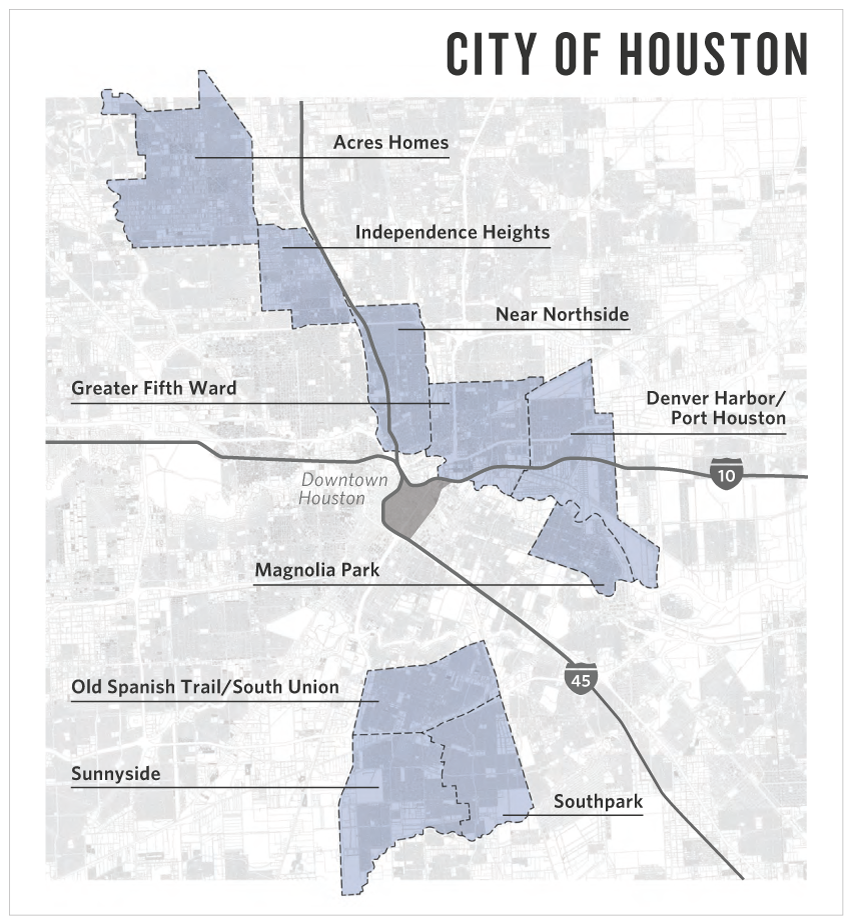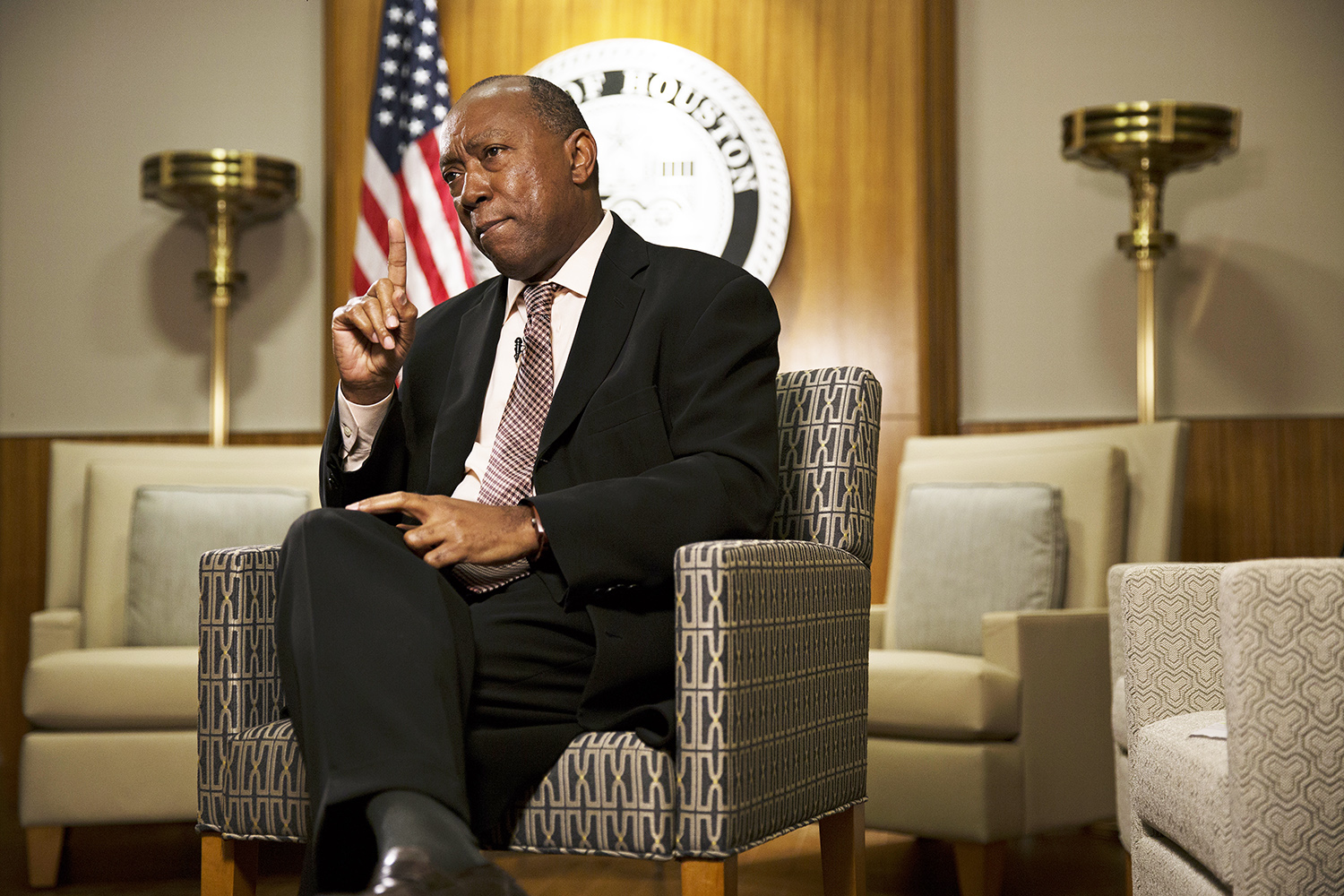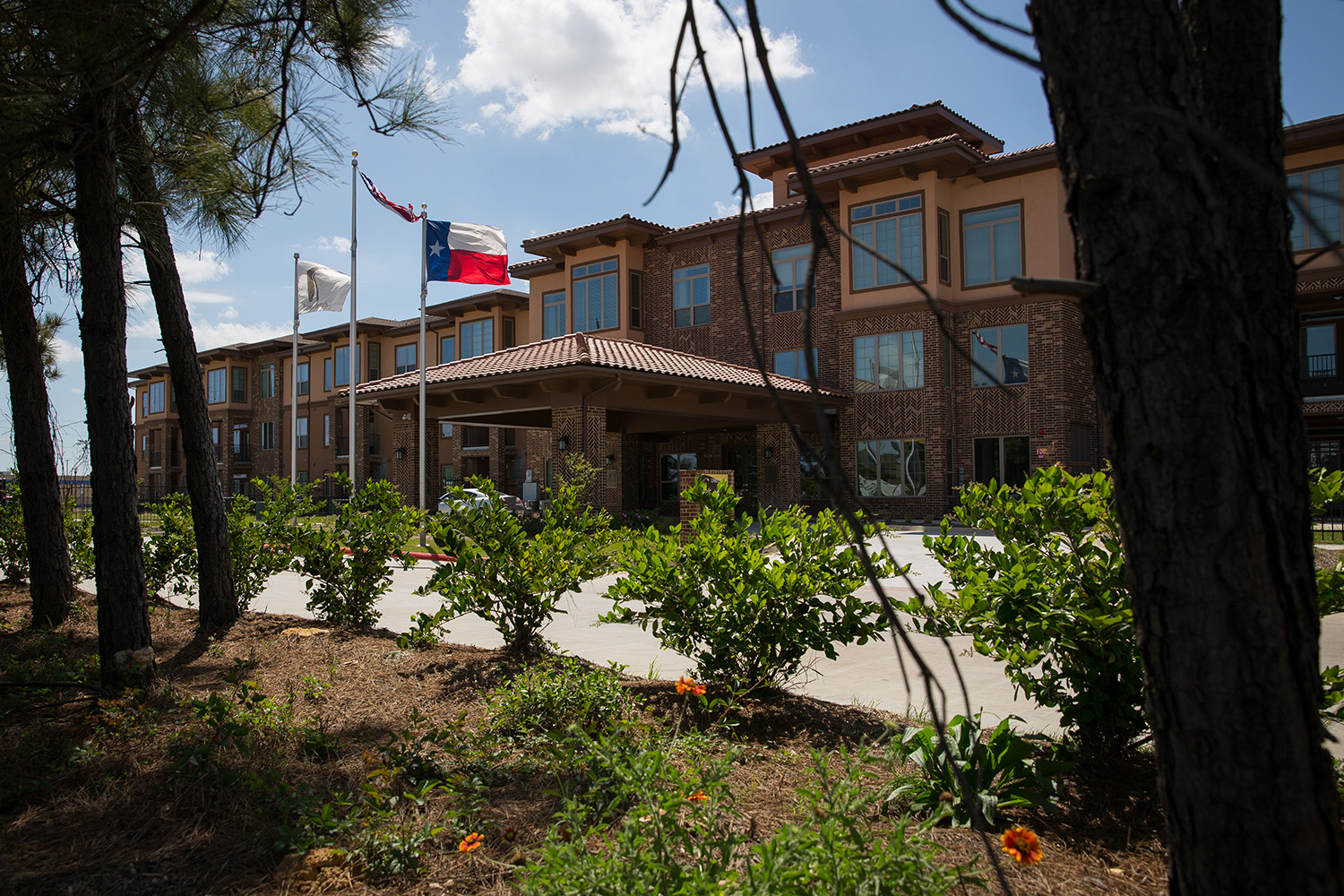A decade after Ike, Houston still hasn’t spent tens of millions it got to build affordable housing
/https://static.texastribune.org/media/files/389e359ae5efeea5627e8f92ab85eb6a/HHA_Tory_Gunsolley_PYH_TT.jpg)
In Harvey's Wake

The devastation was swift, and the recovery is far from over. Sign up for our ongoing coverage of Hurricane Harvey's aftermath.
More in this seriesWhen Tory Gunsolley learned that his agency was about to receive $40 million in federal recovery funds in the wake of Hurricane Ike, he was thrilled.
It was 2011, and the Houston Housing Authority director had recently taken the job after leaving a similar position in Newark. He immediately realized that this new pot of money could be a “once in a generation opportunity” to address Houston’s desperate need for more affordable housing — a chance to build as many as 2,000 new units across Houston for lower-income people.
Seven years later — and a full decade after Ike, the disaster that brought those recovery dollars — Gunsolley chuckles when he thinks back to his original plans. Of the $45 million his agency eventually received from the Department of Housing and Urban Development (HUD), it has managed to build just 154 units of affordable housing with $12 million.
The rest of the money has been embroiled in a fierce fight over how to undo the nation’s legacy of racial segregation in housing.
“Our plans,” Gunsolley said, “got caught up in this national shifting of priorities.”
After Hurricane Ike sent as much as 15 feet of water surging into parts of Harris County and affected nearly 250,000 homes, the area received hundreds of millions of dollars from HUD for housing-related projects. That included more than $200 million to repair and build new apartment complexes across the region.
And just as that money started to flow, prominent members of the Obama administration began pushing for better enforcement of the Fair Housing Act of 1968 — in particular, the need to undo the racial segregation in housing that the federal government had enabled for decades through redlining and discriminatory lending practices. (The administration passed new rules in 2015 to do just that.)
Gunsolley’s agency ended up in the crosshairs. He had originally planned to build several affordable housing projects in predominantly poor and minority areas, but state and federal agencies blocked nearly all of them after fair housing advocates argued they would only serve to perpetuate segregation.

Gunsolley then tried twice to build apartments in wealthier areas. But community opposition and politics killed both of those efforts, too; residents said they worried about more traffic, overcrowded schools, decreasing property values and crime if subsidized apartments went up in their neighborhoods.
In a final attempt to use the rest of the money, the housing authority had been quietly working to buy an existing apartment complex in the well-off Briar Forest neighborhood in West Houston, with hopes to turn about 300 of its units into affordable housing. A week before the deal was set to close, Hurricane Harvey hit and destroyed the complex’s first floor.
Gunsolley’s not sure what will happen next. He’s working on more proposals, but as time goes by the pot of money loses value due to inflation and rising construction prices (Fannie Mae estimates that apartment construction costs have increased nearly 20 percent in the past few years). If the housing authority can’t find consensus on where to spend the remaining tens of millions, Gunsolley worries that Congress may end up asking for its money back — the state has already asked for some unspent Ike recovery funds that aren’t related to housing to be allocated elsewhere.
The debates will only intensify once an even bigger pot of recovery money becomes available in the wake of Hurricane Harvey, which damaged hundreds of public housing units and likely thousands more affordable apartments across Houston.
Fair housing advocates say federal law has always been clear: Federal dollars must be spent in a way that helps undo racial segregation in housing. They’re already gearing up for a fight over how recovery dollars from Hurricane Harvey will be spent.
"Our resources have been consumed by the city of Houston's recalcitrant and obstructionist behavior for a long time,” said John Henneberger, director of the Texas Low-Income Housing Information Service. “We will insist that the money is spent in compliance with civil rights laws.”
Revitalization plans clash with desegregation aims
It started with Sunnyside.
Long considered to be one of Houston’s most distressed neighborhoods, the historically black community south of downtown seemed like an obvious target to Gunsolley for the Ike recovery funds. Starting in 2012, with the support of then-Houston Mayor Annise Parker, he proposed three separate projects in Sunnyside that would create 1,000 affordable housing units — mostly reserved for families with incomes of less than $40,000 a year.
The neighborhood had suffered from decades of underinvestment, and Gunsolley imagined “a whole master-planned community with multi-family housing and single-family housing and retail. We were talking about a charter school, a medical school, a library.”
But fair housing advocates argued that the plan would just further concentrate public and subsidized housing into one area. And they pointed out that the plan called for building most of the housing before building the other revitalization anchors, such as a grocery store or shops. The federal government agreed and blocked all three projects.
A plan to build 200 new affordable units in Acres Homes, another historically black community in Northwest Houston, met the same fate. So did an additional proposal to replace damaged subsidized housing in southeast Houston with a mixed-income development. Only one 154-unit apartment complex north of downtown was approved, and it finally broke ground last year. Housing advocates were not happy; its surrounding census tract has a poverty rate of 35 percent.
“They wanted to rebuild in exclusively segregated, very distressed communities,” said Maddie Sloan, who focuses on disaster recovery and fair housing issues for the advocacy group Texas Appleseed. “The reason that’s particularly problematic is, those are the only places the Houston Housing Authority has ever built housing.”
The issue of where to build new apartments was just one of a string of controversies over how Ike housing recovery money was spent. Texas Appleseed and other groups had already sued the state over how the money earmarked for repairing single-family homes was being distributed, arguing that more should go to help lower-income Houstonians.
The settlement they reached in 2010 helped millions more dollars flow to poor homeowners, Sloan said. But it included one provision that almost everyone agrees has not been achieved — the one that required the state to use Ike money for “affirmatively furthering fair housing” to undo the historic patterns of segregation in housing nationwide.
The concept, technically a part of federal law since 1968, went unenforced for decades. It would involve helping lower-income families move to wealthier, more integrated neighborhoods that tend to have better schools and are often majority-white. (A growing body of research has shown that a person’s ZIP code is a strong indicator of their future health and economic prosperity.)
Houston’s failures to advance fair housing with Ike recovery dollars weren’t for complete lack of trying. One program offered 260 low- and moderate-income Houstonians the chance to rebuild their flooded homes somewhere else in the city — “the first program of its kind in the country,” according to Sloan. Only seven of them took that option.
In wealthier neighborhoods, more resistance
By 2015 — four years after the money had first been announced — nearly all of the proposed housing projects had been blocked. Gunsolley knew he needed a different approach.
To comply with federal rules and overcome resistance from the housing advocates, he needed to build affordable housing in a wealthy neighborhood with good schools.
First, the housing authority tried to buy the site of a shuttered transit station in a northwest Houston neighborhood called Fairbanks/Northwest Crossing, hoping to build 300 affordable units there. An outcry from neighbors soon followed, with 200 residents showing up to a public meeting to voice their opposition, according to local media reports. They worried about increased crime and traffic and said they preferred commercial development over residential buildings. So Houston’s transit agency, which owned the site, opted to sell it to Harris County to build government offices instead.
Then the opportunity came up to buy the land right underneath the agency’s offices at 2640 Fountain View Drive, as well as a tract of land next door. The agency could own land in a prime neighborhood — the wealthy Galleria district, surrounded by luxury apartments — and build affordable units on it.
But there was still a hurdle: The Ike recovery dollars wouldn’t pay for the entire $53 million project, so the housing authority applied for a tax credit to fill the gap. Thanks to a little-known state law passed in 2013, the Houston City Council would need to issue a “resolution of no objection” for the tax credit to go through.
When nearby residents got wind of the plans for 2640 Fountain View, they mounted a fierce opposition campaign. In an angry meeting in early 2016, hundreds of people booed Gunsolley and others who spoke in favor of the project. They echoed the concerns of those who opposed similar housing in Fairbanks/Northwest Crossing — fears of increased crime, traffic and overcrowded schools.
They also took aim at the cost of the project, which amounted to around $240,000 per unit. “This is not affordable housing, rather this is unaffordable housing,” Greg Travis, the Houston councilman who represents the Galleria area, wrote in a letter opposing the project.
The project’s supporters countered that the other subsidized housing project built with Ike recovery funds, in a much poorer part of Houston, cost nearly the same amount per unit and didn’t meet any community opposition.
The Republican congressman who represents the area, John Culberson, also came to the meeting and harshly criticized the plan — attacking the very idea that the federal government should advance fair housing by placing low-income housing in predominantly white neighborhoods.
“This has opened my eyes,” he told the audience, amid cheers and applause. “I’ve already drafted amendments to federal law to make sure that in future, American law, when it comes to housing, has to be race-neutral. You cannot look at the racial makeup of a neighborhood when deciding where to build housing.”
Houston Mayor Sylvester Turner agreed that the project was too expensive, and he also argued that poor families shouldn’t be forced to move to wealthier neighborhoods in order to succeed. When Turner, who declined to comment for this story, refused to put the project on the city council agenda for a vote, it couldn’t get the tax credit it needed. The project was dead.

In a scathing letter last year, HUD said the city violated the Civil Rights Act when it killed the Fountain View project.
“The Fountain View proposal would have provided housing opportunities for minority residents in a largely white neighborhood,” the agency wrote, adding that “local opposition was at least in part racially motivated and was factually unfounded.” HUD also pointed out that a 281-unit apartment complex had been built next door to Fountain View just two years earlier — without any affordable units or community outcry.
While Turner strongly contested the finding, HUD’s words didn’t carry much of a hammer. The letter was sent just days before Donald Trump was sworn into office, and his choice to lead HUD, Ben Carson, has referred to the idea of using federal money to advance fair housing as an example of “failed socialism” and “social engineering.”
Earlier this month, HUD signed a short agreement with the city that seemed to table the issue, but advocates say they will fight back. The agreement “basically required the city to do virtually nothing different than what it's been doing historically,” said Henneberger of the Texas Low-Income Housing Information Service. His group has since sued HUD, arguing that the agency shouldn’t give Houston any more hurricane recovery dollars without taking “effective actions to compel Houston to adjust its housing policies and practices to overcome such segregation.”
Gunsolley said he will keep trying to use the remainder of the Ike recovery money to build housing in a wealthier neighborhood with good schools. But his agency has also argued that might be too much of a hurdle.
“It is cost prohibitive and not an effective use of [our] limited resources to develop only in high opportunity areas,” the housing authority wrote in a 2015 legal brief. “Affordable housing would never get built.”
Sloan, of Texas Appleseed, called that argument “horrifying.” She said the city needs to use recovery dollars to both revitalize distressed areas and to advance fair housing. She added that fair housing isn’t just about undoing racial segregation — it can also help make Houston more resilient for the next disaster.
After all, she pointed out, “the Fountain View site didn’t flood during Harvey.” Indeed, the entire Galleria area remained mostly high and dry.
Will Harvey money meet the same fate?
The Houston Housing Authority isn’t the only agency with Ike recovery dollars tied up in fights over affordable housing.
The city’s housing department, a separate agency, decided to build housing in areas that are gentrifying in an attempt to placate both fair housing advocates and potential neighborhood opposition. But the developer for one such project in the city’s predominantly black Fifth Ward wants to build townhomes that will sell for $350,000-$450,000. Tom McCasland, who became director of the housing department after that deal was made, said he’s re-negotiating to make sure affordable housing gets incorporated into the project, and he's withholding about $7.5 million in Ike recovery funds as leverage.
And once the Harvey money becomes available, McCasland and other directors of government housing programs are sure that the fight over fair housing will only intensify. After Ike, Texas received just over $3 billion in total from HUD; the initial HUD allocation for the state since Harvey is already $5 billion, with much more expected.
“We need to look at affordable housing that’s open to families,” said Daphne Lemelle, Harris County’s community development director. “I try to be optimistic that the community at large can understand the need for this, but obviously, we have people that feel that’s not for their community.”
Lemelle’s department was able to use Ike recovery dollars to build one subsidized apartment complex in the wealthy Houston suburb of Tomball, but only seniors age 62 and older are allowed to live there.

It’s not clear how the housing money from Harvey will be spent just yet, and it could be months — or even years — before those questions are answered. But McCasland is hopeful that things will go differently this time around and that the city will get the money to both revitalize impoverished neighborhoods and build affordable housing in better neighborhoods.
“Residents have a right to stay in communities where they’ve grown up, but they also have the right to choose to move to other neighborhoods that maybe have better schools or are closer to their jobs,” he said. “That’s the dual obligation that we have. Harvey is now the opportunity to execute on the promise that for a long time has been denied to some of these neighborhoods and residents.”
Turner echoed those comments in a city press release issued earlier this month. “If there is a silver lining to Harvey’s devastating cloud, it is that the amount of federal funding headed our way will allow us to reimagine the kind of city Houston can be,” he said in the release.
Could the city really build something like a Fountain View project with Harvey recovery dollars and overcome political opposition? Gunsolley wonders if starting the process sooner — and giving neighbors more time to understand and absorb the proposal — would have reduced the opposition.
“But I’m not confident that it would have made a difference,” he said.
Disclosure: Texas Appleseed has been a financial supporter of The Texas Tribune, a nonprofit, nonpartisan news organization that is funded in part by donations from members, foundations and corporate sponsors. Financial supporters play no role in the Tribune's journalism. Find a complete list of them here.
Information about the authors
Learn about The Texas Tribune’s policies, including our partnership with The Trust Project to increase transparency in news.
/https://static.texastribune.org/media/profiles/Neena_1.jpg)